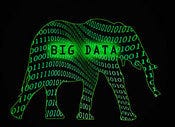Big Data App IDs Lookalike Prescription PillsBig Data App IDs Lookalike Prescription Pills
Drawing on an extensive database of pill images, the MedSnap ID app for medical professionals uses the iPhone to quickly identify prescription pills and reduce medication errors.


5 Big Wishes For Big Data Deployments
5 Big Wishes For Big Data Deployments(click image for larger view and for slideshow)
Here's an unpleasant scenario: You suddenly fall ill while out of town and hurry to the nearest ER. You wisely bring along your prescription pills -- all mixed together in one unmarked bottle -- but are too woozy to remember the names and doses of your medications.
Situations like these make life difficult for ER physicians and other medical professionals, who often are forced to make life-or-death decisions based on scant information about their patients' prescription drug usage. But MedSnap ID, a new subscription service from MedSnap, a Birmingham, Ala.-based startup, aims to improve things by identifying prescription pills visually to improve medication adherence and safety.
"Medication safety is something that's very important and expensive to U.S. healthcare, but it's also something that affects people personally," said Dr. Patrick Hymel, MedSnap's CEO and cofounder, in a phone interview with information.
[ Want to make a baby -- pronto? Read Big Data Knows When You're Fertile. ]
With a background as an ER doctor, Hymel has first-hand knowledge of the problems that MedSnap ID aims to solve. "I had emergency experiences with patients bringing in pills and not knowing what those pills do," Hymel said. "Trying to get a history from a patient of what they've taken, it's very difficult."
Of course, medical professionals can make medication mistakes too, and these infrequent errors can prove deadly. A distracted doctor, for instance, might write a prescription incorrectly, or a pharmacist might dispense the wrong drug or dosage.
"These types of errors are very difficult to detect if you've got five minutes to talk to a patient in the emergency room," said Hymel. Enter MedSnap ID, a subscription service -- $70 a year per individual license -- for medical professionals. Using image recognition, it identifies more than 3,400 U.S. prescription pills, with more pills added weekly, the company says.
Using an iPhone 4S or 5 and the MedSnap ID app, an ER physician, for instance, can snap a picture of a mixed set of pills placed on a flat surface, and after a brief analysis, MedSnap ID will display a list of pills it has identified.
"You could put up to 20 or more pills on the surface, and it will identify each and every pill from its image," Hymel said. "The FDA mandates that every pill have a unique side. So its color, shape, size, and imprint -- some combination of those factors need to be unique. We use that to identify the medication."
Visual identification can be tricky with generic medications, however.
"The problem for both patients and clinicians is that one medication can have many different appearances," said Hymel, adding that until starting the MedSnap project, he had written tens of thousands of prescriptions with "very little idea" of what the pills actually looked like.
MedSnap ID's usefulness depends on the depth and breadth of its visual database, of course, which is why the company is enlisting hospitals, pharmacy schools and clinicians to join its Pill Mapping Project, an effort to ID thousands of prescription pills.
"We've had pharmacists volunteer to participate in this," noted Hymel. "We've had hospitals donate their pills and allow us to come into their pharmacies and snap 800 or 900 different medications that they stock. All of that was necessary to build up the pill database that we have."
The influx of international drugs might limit the usefulness of MedSnap in some areas, such as border states and major tourist destinations that attract a lot of international visitors.
A pill that MedSnap ID can't identify might be one that comes from a source outside the U.S., Canada or European Union, or it might be a fake.
"There's a lot of interest in using this technology to evaluate the safety of the drug supply chain, and to make sure the drugs we're about to take are the drugs we think they are," said Hymel.
The big data market is not just about technologies and platforms -- it's about creating new opportunities and solving problems. The Big Data Conference provides three days of comprehensive content for business and technology professionals seeking to capitalize on the boom in data volume, variety and velocity. The Big Data Conference happens in Chicago, Oct. 21-23.
Read more about:
2013About the Author
You May Also Like






